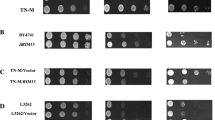Abstract
The COT1 and ZRC1 genes of Saccharomyces cerevisiae are structurally related dosage-dependent suppressors of metal toxicity. COT1 confers increased tolerance to high levels of cobalt; ZRC1 confers increased tolerance to high levels of zinc. The two genes are not linked and have been mapped; COT1 to chromosome XV and ZRC1 to chromosome XIII. Phenotypes related to metal homeostasis have been examined in strains with varied COT1 and ZRC1 gene doses. Overexpression of COT1 confers tolerance to moderately toxic levels of zinc and ZRC1 confers tolerance to moderately toxic levels of cobalt. Strains that carry null alleles at both loci are viable. The metal-hypersensitive phenotypes of mutations in either gene are largely unaffected by changes in dosage of the other. COT1 and ZRCI function independently in conferring tolerance to their respective metals, yet the uptake of cobalt ions by yeast cells is dependent on the gene dosage of ZRC1 as well as of COT1 Strains that overexpress ZRC1 have increased uptake of cobalt ions, while ZRCI null mutants exhibit decreased cobalt uptake. The defects in cobalt uptake due to mutations at COT1 and ZRC1 are additive, suggesting that the two genes are responsible for the majority of cobalt and zinc uptake in yeast cells. The function of either gene product seems to be more important in metal homeostasis than is the GRR1 gene product, which is also involved in metal metabolism. Mutations in the GRR1 gene have no effect on the cobalt-related phenotypes of strains that have altered gene dosage of either COT1 or ZRC1.
Similar content being viewed by others
References
Conklin DS, McMaster JA, Culbertson MR, Kung C (1992) COT1, a gene involved in cobalt accumulation in Saccharomyces cerevisiae. Mol Cell Biol 12:3678–3688
Conklin DS, Kung C, Culbertson MR (1993) The COT2 gene is required for glucose-dependent divalent cation transport in Saccharomyces cerevisiae. Mol Cell Biol 13:2041–2049
Flick JS, Johnston M (1991) GRR1 of Saccharomyces cerevisiae is required for glucose repression and encodes a protein with leucine-rich repeats. Mol Cell Biol 11:5101–5112
Gadd GM, White C (1989) Heavy metal and radionuclide accumulation and toxicity in fungi and yeasts. In: Poole RK, Gadd GM (eds) Metal-microbe interactions. IRL Press, Oxford, pp 19–38
Hanahan D (1983) Studies on transformation of E. coli with plasmids. J Mol Biol 166:557–580
Hartmann H-J, Weser U (1985) Cobalt-(cysteinyl)4 tetrahedra in yeast cobalt(II)-thionein. Biochem Biophys Res Commun 132:277–283
Hay RW (1984) Bio-inorganic chemistry. John Wiley and Sons, New York
Hill JE, Meyers AM, Koerner TJ, Tsagoloff A (1986) Yeast/E. coli shuttle vectors with multiple unique restriction sites. Yeast 2:163–167
Hoffman CS, Winston F (1987) A ten minute DNA preparation from yeast efficiently releases autonomous plasmids for transformation of Escherichia coli. Gene 57:267–272
Hughes MN (1981) The inorganic chemistry of biological processes. John Wiley and Sons, New York
Ito H, Fukuda Y, Murata K, Kimura A (1983) Transformation of intact yeast cells treated with alkali cations. J Bacteriol 153:163–168
Jeyaprakash A, Welch JW, Fogel S (1991) Multicopy CUP1 plasmids enhance cadmium and copper resistance levels in yeast. Mol Gen Genet 225:363–368
Kamizono A, Nishizawa M, Teranishi Y, Murata K, Kimura A (1989) Identification of a gene conferring resistance to zinc and cadmium ions in the yeast Saccharomyces cerevisiae. Mol Gen Genet 219:161–167
Maniatis T, Fritsch EF, Sambrook J (1982) Molecular cloning: a laboratory manual. Cold Spring Harbor Laboratory, Cold Spring Harbor, New York
Mehra RK, Winge DR (1991) Metal ion resistance in fungi: molecular mechanisms and their regulated expression. J Cell Biochem 45:30–40
Olson MV, Dutchik JE, Graham MY, Brodeur GM, Helms C, Frank M, MacCollin M, Scheinman R, Frank T (1986) Random-clone strategy for genomic restriction mapping in yeast. Proc Natl Acad Sci USA 83:7826–7830
Rothstein RJ (1983) One-step gene disruption in yeast. Methods Enzymol 101:202–211
Sherman F (1991) Getting started with yeast. Methods Enzymol 194:3–21
Sherman F, Wakem P (1991) Mapping yeast genes. Methods Enzymol 194:38–57
Winge DR, Nielson KB, Gray WR, Hamer DH (1985) Yeast metallothionein. J Biol Chem 260:14464–14470
Author information
Authors and Affiliations
Additional information
Communicated by D. Y Thomas
Rights and permissions
About this article
Cite this article
Conklin, D.S., Culbertson, M.R. & Kung, C. Interactions between gene products involved in divalent cation transport in Saccharomyces cerevisiae . Molec. Gen. Genet. 244, 303–311 (1994). https://doi.org/10.1007/BF00285458
Received:
Accepted:
Issue Date:
DOI: https://doi.org/10.1007/BF00285458




